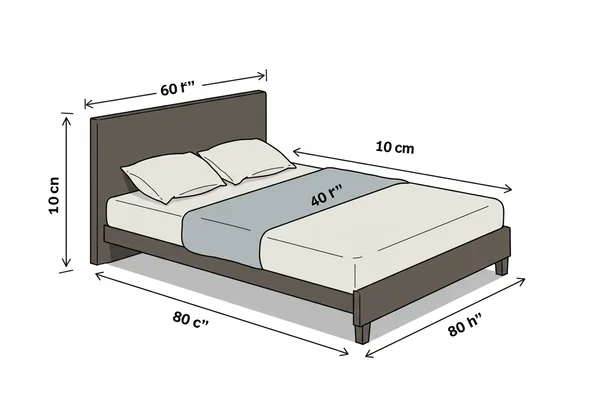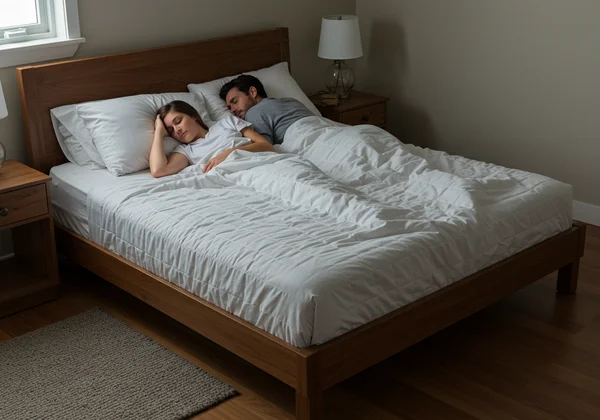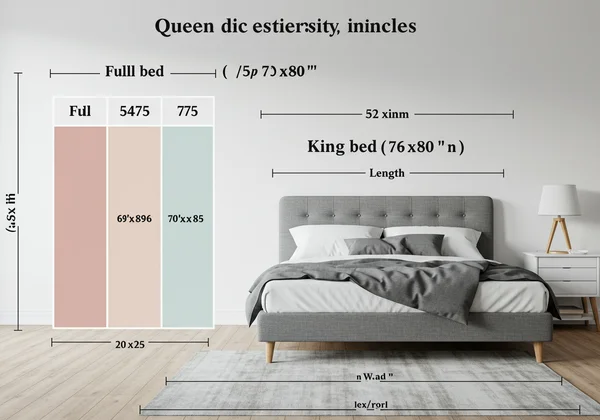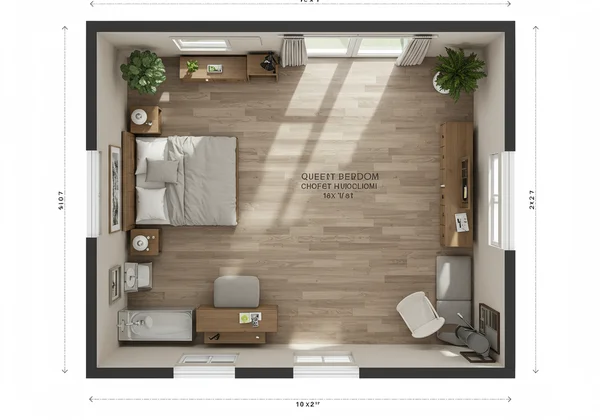Queen Bed Dimensions: Ultimate Guide for Your Space
Are you considering a Queen bed but feeling overwhelmed by the choices? The world of mattress sizes can be confusing, but understanding the queen bed dimensions is the first step toward creating your perfect sleep sanctuary. What are the dimensions of a queen size bed, and how do you know if it's the right fit for your lifestyle and your room? This guide will break down everything you need to know, from exact measurements to ideal room layouts.
This guide will give you the essential knowledge to make a smart decision. But for a truly personalized answer, our intelligent tool can provide a data-driven recommendation based on your unique needs. Find your perfect fit today!
What Are Standard Queen Bed Dimensions?
Before you can decide if a Queen bed is right for you, it's crucial to know its exact size. Unlike vague descriptions, mattress dimensions are standardized, ensuring that a Queen bed frame will fit a Queen mattress, no matter where you buy them. This consistency is key to confident furniture planning and purchasing.
Exact Measurements: Inches vs. Centimeters
The standard queen mattress size is a well-defined industry measurement. This ensures that accessories like sheets, comforters, and bed frames are universally compatible.
- Inches: A standard Queen mattress measures 60 inches wide by 80 inches long.
- Centimeters: For our international users, this translates to 152 cm wide by 203 cm long.
This size provides a comfortable balance, offering more width than a Full bed and more length than a Twin, making it the most popular mattress size in many countries. It's a versatile choice that fits well in most master or guest bedrooms.

Understanding Queen Mattress Depth and Thickness
Beyond width and length, another critical dimension is the mattress thickness, or depth. This is not standardized and can range significantly, typically from 8 to over 16 inches. The depth affects the overall height of your bed, the type of sheets you need (look for "deep pocket" sheets for thicker mattresses), and the aesthetic appeal within your room. A thicker mattress can feel more luxurious but will also raise you further from the floor.
Who Is a Queen Size Bed Ideal For?
A queen size bed is popular for its versatility, making it a great choice for many sleepers and living situations. It offers a great balance: ample space without being too large for most standard bedrooms. Whether you're a first-time buyer, a couple upgrading, or a family looking for flexibility, the Queen often emerges as the top choice.
Queen for Couples: Balancing Comfort and Intimacy
For couples, a Queen bed is often the default choice. It provides 30 inches of personal space for each person, which is enough for most couples to sleep comfortably without feeling cramped. It’s a significant upgrade from a Full bed, which only offers 27 inches per person. This size is perfect for partners who enjoy sleeping in close proximity while still having enough room to shift positions during the night. The queen bed for couples is a classic because it fosters intimacy while still respecting personal sleep space.

Ideal for Single Sleepers & Growing Families
A Queen bed isn't just for couples. For single sleepers, it offers a luxurious amount of space to stretch out and relax. If you’re an active sleeper or simply enjoy the feeling of an expansive bed, a Queen provides that without the massive footprint of a King. It’s a popular choice for master bedrooms for individuals. Furthermore, it's a practical option for small families—perfect for a parent co-sleeping with a young child or for weekend morning cuddles with kids and pets.
Advantages & Disadvantages of Choosing a Queen Bed
While the Queen bed is the most popular size, it isn't automatically the right choice for everyone. Understanding its pros and cons is essential for making an informed decision that you'll be happy with for years to come. Weighing these factors against your personal needs, room size, and sleep habits is the key to success.
The Perks: Why Queen Reigns Popular
Queen beds are popular for good reason. They offer several compelling advantages that make them the top mattress choice.
- Space Efficiency: It offers a generous sleeping area while still fitting comfortably in most bedrooms (typically 10x10 feet and up).
- Accessory Availability: As the most common size, finding bedding, bed frames, and headboards is incredibly easy and often more affordable than for less common sizes.
- Comfort for Most: It suits single sleepers who love space and most couples who don't require the vast expanse of a King.
- Resale Value: If you ever need to move and sell your bed frame, a Queen size is more likely to attract buyers.
Potential Downsides: When to Consider Other Sizes
Despite its many benefits, there are situations where a Queen bed might not be the optimal choice. For some couples, especially if one partner is a restless sleeper, the 30 inches of personal space might feel restrictive. In this case, upgrading to a King bed, which offers 38 inches per person, could significantly improve sleep quality.
Additionally, very tall individuals (over 6'2" or 188 cm) might find the 80-inch length adequate but may prefer the extra legroom of a California King. For very small rooms, a Full bed might be a more practical choice to preserve walking space. To see how these sizes stack up, you can compare bed sizes on our site.

Optimal Room Size & Layout for Your Queen Bed
Placing a bed is about more than just fitting it through the door. A well-planned bedroom layout ensures comfort, functionality, and a sense of calm. A Queen bed requires thoughtful placement to maximize both your sleeping area and your living space.
Minimum Room Dimensions for Comfortable Placement
As a general rule, the minimum room size for a Queen bed is 10 feet by 10 feet. This provides enough space to place the bed in the center of a wall and still have about 30 inches of clearance on either side and at the foot of the bed. This clearance is crucial for making the bed, accessing closets, opening drawers, and navigating the room without feeling cramped. For a more spacious feel, a room size of 10 feet by 12 feet or larger is even better.
Smart Layout Tips for Queen Beds in Various Bedroom Types
How you position your bed can dramatically change the feel of your room. Here are a few layout tips for your Queen bed:
-
In a Master Bedroom: Center the bed against the wall opposite the door to create a welcoming focal point. Flank it with two nightstands for symmetry and convenience.
-
In a Small Bedroom: If space is tight, push the bed against a corner. This opens up the floor area, though it means one person may have to climb over the other to get out.
-
In a Guest Room: A Queen bed is an excellent choice for a guest room, as it comfortably accommodates both single visitors and couples. Ensure guests have easy access to one side of the bed and a surface for their belongings.

Finding Your Perfect Queen Fit
Choosing a mattress size is a major decision. The Queen bed offers a fantastic balance of comfort, size, and practicality, making it a top choice for many. It’s spacious enough for couples, luxurious for singles, and fits well in the average bedroom. However, the information in this guide is general. Your body, your room, and your sleep habits are unique.
To eliminate the guesswork, the best next step is to use our intelligent recommendation tool. By inputting your specific data—like height, sleep position, and bedroom size—you can get a personalized, data-backed suggestion in seconds. Stop wondering and start knowing. Get your recommendation on our homepage now!
Frequently Asked Questions About Queen Bed Sizes
How wide is a standard Queen bed?
A standard Queen bed is 60 inches (152 cm) wide. This provides 30 inches of space per person for a couple, which is 3 inches more per person than a Full bed.
Can two people comfortably sleep on a Queen size bed?
Yes, for most couples, a Queen size bed offers enough space for comfortable sleep. It's the most popular choice for couples. However, if either partner is a particularly restless sleeper or desires more personal space, a King bed might be a better option.
What is the smallest room size suitable for a Queen bed?
We recommend a room that is at least 10 feet by 10 feet. This allows for the bed itself and provides enough clearance (about 30 inches) around it for movement and other furniture like nightstands.
How does a Queen compare to a Full or King in terms of dimensions?
A Queen (60" x 80") is 6 inches wider and 5 inches longer than a Full (54" x 75"). A King (76" x 80") is the same length as a Queen but is 16 inches wider, offering significantly more personal space for couples.
How can I find the perfect mattress size for my needs?
While guides like this are helpful, the most accurate way is to use a tool that considers your personal data. Our intelligent recommender tool is designed to help. Simply enter your height, weight, room size, and sleep preferences to get a customized suggestion. Try our free tool today and make your decision with confidence.